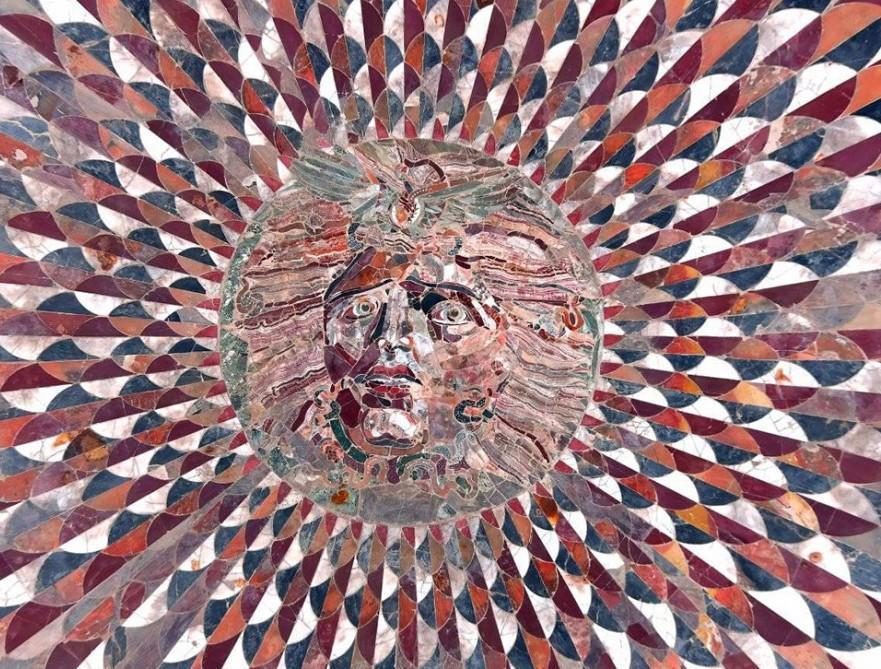
The ancient city of Kibyra in the Gölhisar district of the southern province of Burdur welcomed 18,000 visitors this year.
The ancient city’s Medusa mosaic, a 2,000-year-old “snake-haired, sharp-toothed female monster” figure, is opened to visitors every year in May and covered in winter. It is the most important attraction in the region. Now the mosaic will be covered in order to prevent it from receiving damage during the harsh winter conditions.
The 2,300-year-old Kibyra, also known as the “City of Gladiators,” entered the UNESCO World Heritage Tentative List in 2016. It draws attention with its gigantic monumental structures. The city has a stadium with a capacity of 10,000 people, built in the Roman and Byzantine architectural traditions.
Apart from the late Roman bath, agoras, main street, a huge theater for 9,000 people and underground chamber tombs, it is also home to an orchestra section covered with Medusa mosaic, which is unique in the world. The Medusa mosaic was unearthed during the 2009 excavations in the Odeon section of the ancient city.
The mosaic, which cannot be exhibited throughout the year due to climatic conditions, will be closed to visitors in the coming days.
The head of Kibyra excavations, Mehmet Akif Ersoy University Archeology Department Lecturer Associated Professor Şükrü Özüdogru emphasized that the Medusa mosaic was built of colored marbles with the “Opus Sectile” technique in the first phases of the first century A.D. Especially with its construction technique, it is the one and only in the world.
“The only Medusa with the ‘Opus Sectile’ technique is in the Kibyra Odeon. The demand to see Medusa is high, the number of our visitors has increased in recent years, but Medusa is closed for a certain period of time every year for protection purposes,” he said.
Providing information about the Kibyra Odeon and the Medusa mosaic, Özüdogru said, “Kibyra Odeon structure is located on the southwest corner of Merkez Tepe, where the city’s public buildings are located. It is understood from the inscription in the Odeon Stoa in the front of the structure that the structure was called ‘Odeon’ [music house, concert hall] in the ancient ages. The inscription writes that the mosaic floor of the stoa in front of the Odeon was built by the brothers Aurelius Sopatros and Claudius Theodoros between 249-254.”
Stating that Odeon also served as a city council (bouleuterion) and a theater covered with a roof with a stage building (skene), Özüdoğru said, “In addition, since Kibyra was one of the judicial centers [conventus] of the Province of Asia Minor during the Roman Imperial period, it must have been used as a courthouse. Odeon has an audience capacity of approximately 2,500-3,000 people with 31 rows of seats inside. As such, it was the largest public structure in our country in the ancient period. It was covered with a roof.”
“On the floor of the orchestra section of the structure, there is a depiction of Medusa - a mythological figure, which is believed to turn anyone who looks into her eyes into stone - consisting of colored marble plates (opus sectile). In terms of its construction technique, no similar Medusa figure is known yet, so that it is unique,” he said.
Medusa in mythology
In Greek mythology, Medusa was a monster, generally described as having the face of a hideous human female with live venomous snakes in place of hair. Gazing directly upon her would turn onlookers to stone. Most sources describe her as the daughter of Phorcys and Ceto. Medusa was beheaded by the hero Perseus, who used her head as a weapon until he gave it to the goddess Athena to place on her shield. In classical antiquity, the image of the head of Medusa appeared in a device that fends off evil known as the Gorgoneion.